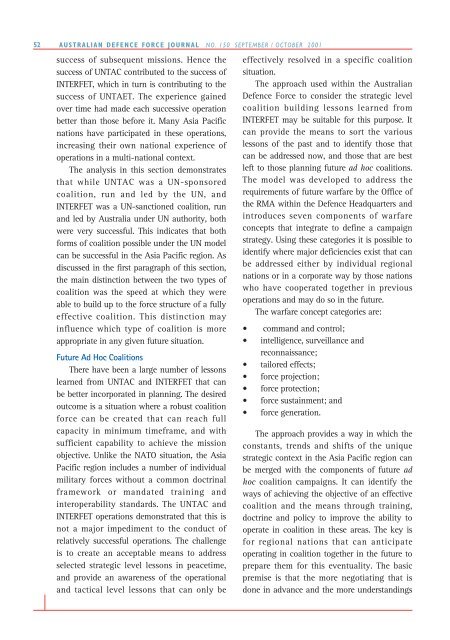ISSUE 150 : Sep/Oct - 2001 - Australian Defence Force Journal
ISSUE 150 : Sep/Oct - 2001 - Australian Defence Force Journal
ISSUE 150 : Sep/Oct - 2001 - Australian Defence Force Journal
Create successful ePaper yourself
Turn your PDF publications into a flip-book with our unique Google optimized e-Paper software.
52AUSTRALIAN DEFENCE FORCE JOURNAL NO. <strong>150</strong> SEPTEMBER / OCTOBER <strong>2001</strong>success of subsequent missions. Hence thesuccess of UNTAC contributed to the success ofINTERFET, which in turn is contributing to thesuccess of UNTAET. The experience gainedover time had made each successive operationbetter than those before it. Many Asia Pacificnations have participated in these operations,increasing their own national experience ofoperations in a multi-national context.The analysis in this section demonstratesthat while UNTAC was a UN-sponsoredcoalition, run and led by the UN, andINTERFET was a UN-sanctioned coalition, runand led by Australia under UN authority, bothwere very successful. This indicates that bothforms of coalition possible under the UN modelcan be successful in the Asia Pacific region. Asdiscussed in the first paragraph of this section,the main distinction between the two types ofcoalition was the speed at which they wereable to build up to the force structure of a fullyeffective coalition. This distinction mayinfluence which type of coalition is moreappropriate in any given future situation.Future Ad Hoc CoalitionsThere have been a large number of lessonslearned from UNTAC and INTERFET that canbe better incorporated in planning. The desiredoutcome is a situation where a robust coalitionforce can be created that can reach fullcapacity in minimum timeframe, and withsufficient capability to achieve the missionobjective. Unlike the NATO situation, the AsiaPacific region includes a number of individualmilitary forces without a common doctrinalframework or mandated training andinteroperability standards. The UNTAC andINTERFET operations demonstrated that this isnot a major impediment to the conduct ofrelatively successful operations. The challengeis to create an acceptable means to addressselected strategic level lessons in peacetime,and provide an awareness of the operationaland tactical level lessons that can only beeffectively resolved in a specific coalitionsituation.The approach used within the <strong>Australian</strong><strong>Defence</strong> <strong>Force</strong> to consider the strategic levelcoalition building lessons learned fromINTERFET may be suitable for this purpose. Itcan provide the means to sort the variouslessons of the past and to identify those thatcan be addressed now, and those that are bestleft to those planning future ad hoc coalitions.The model was developed to address therequirements of future warfare by the Office ofthe RMA within the <strong>Defence</strong> Headquarters andintroduces seven components of warfareconcepts that integrate to define a campaignstrategy. Using these categories it is possible toidentify where major deficiencies exist that canbe addressed either by individual regionalnations or in a corporate way by those nationswho have cooperated together in previousoperations and may do so in the future.The warfare concept categories are:• command and control;• intelligence, surveillance andreconnaissance;• tailored effects;• force projection;• force protection;• force sustainment; and• force generation.The approach provides a way in which theconstants, trends and shifts of the uniquestrategic context in the Asia Pacific region canbe merged with the components of future adhoc coalition campaigns. It can identify theways of achieving the objective of an effectivecoalition and the means through training,doctrine and policy to improve the ability tooperate in coalition in these areas. The key isfor regional nations that can anticipateoperating in coalition together in the future toprepare them for this eventuality. The basicpremise is that the more negotiating that isdone in advance and the more understandings
















